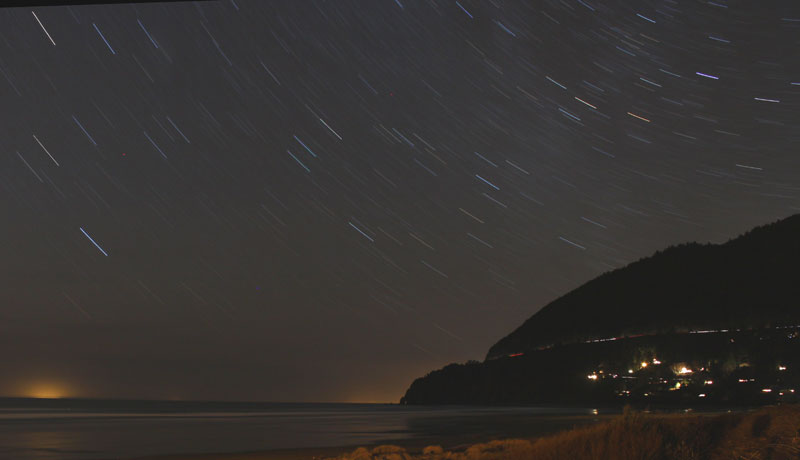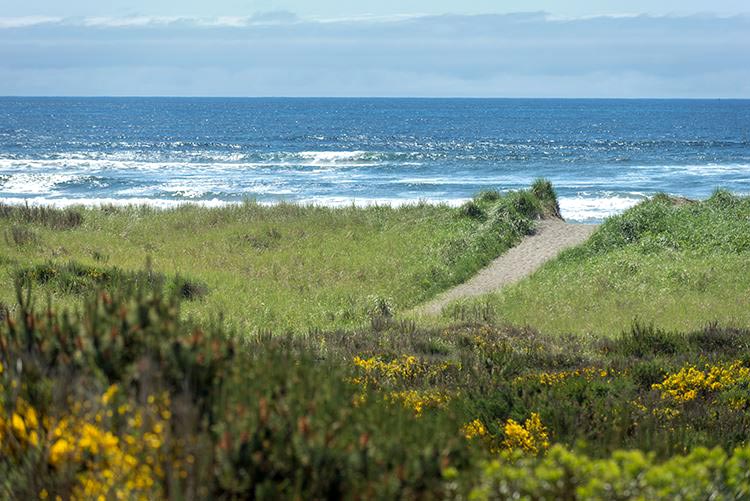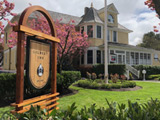Fall Equinox and Its Interesting, Colorful Aspects on Washington / Oregon Coast
Published 09/17/21 at 5:46 PM PDT
By Andre' GW Hagestedt

Includes exclusive listings; some specials in winter
In Cannon Beach:
Includes rentals not listed anywhere else
In Manzanita, Wheeler, Rockaway Beach:
Some specials for winter
In Pacific City, Oceanside:
Some specials for winter
In Lincoln City:
Some specials for winter
In Depoe Bay, Gleneden Beach:
Some specials for winter
In Newport:
Look for some specials
In Waldport
Some specials for winter
In Yachats, Florence
Some specials for winter
Southern Oregon Coast Hotels / Lodgings
Reedsport to Brookings, places to stay; winter deals
(Astoria, Oregon) – Summer comes to a close on Northwest beaches with some engaging astronomy tidbits and fun sights still to be encountered. Among them: a harvest moon with a different color, lovely weather waiting in the wings and maybe something odd glowing at night. (Above: after dark at Manzanita)
The Oregon coast and Washington coast will officially say goodbye to summer on September 22 at 12:21 p.m., as the autumnal equinox kicks in.
Jim Todd, astronomy expert with Portland's OMSI, said this is what happens along the entire northern Hemisphere, a date that marks when the days really start getting shorter and the nights are longer. There is a significant shift in the times of day and night.
“This is the moment in time where the Sun's rays are directly over the equator and the days are nights are nearly equal in length,” Todd said. “The Sun's rays continue to make their journey south, and as a result, hours of darkness will be longer than daylight. This is the reason it's called an ‘equinox,' Latin word meaning ‘equal.'
In and around Portland, September 25 is actually when day and night both get to 12 hours each, with sunrise in Ptown happening at 7:01 a.m. and sunset at 7:02 p.m.
In a way, it centers around the 45th latitude North – which runs right near Neskowin and Lincoln City.
“At the 45th latitude North, the time it takes for the sun to fully rise and set, which is several minutes, is added to the day and subtracted from the night, and therefore the equinox day lasts a little longer than 12 hours,” Todd said. “Another reason why the day is longer than 12 hours on an equinox is that the Earth's atmosphere refracts sunlight.”
Around the world, autumnal equinox coincides with many cultural events, religious observances, and customs around the world, Todd said.

Harvest moon above Newport, after it's moved above the horizon and no longer orange
“For example, the Chinese Mid-Autumn Festival, also known as the Moon Festival, is a harvest festival also celebrated in Vietnam, Taiwan, and Hong Kong,” he said. “Locally, modern Harvest Moon festivals with variety of concerts, farmers markets, beer- and wine-tasting, and craft fairs. The wonderful changing fall color of the trees in the Pacific Northwest is expected for rest of September and well into October this year. This is a perfect opportunity to align sundial as the Sun rises due east and sets due west on the equinox.”
For the Oregon and Washington coastlines, this season brings the “second summer,” where weather is generally at its nicest of all the year. Due to a special set of meteorological circumstances, you'll get less winds, warmer temps and bluer skies – although not all the time, of course. This weekend is expecting the largest storm system to hit the Pacific Northwest in months.
Other special aspects: when warmer temps return to the beaches, look around darker beaches for the “glowing sand” phenomena, which is caused by bioluminescent phtyoplankton. Head to a beach with no light interference (and no moon helps), such as those along Long Beach, southern Cannon Beach, Manzanita, Oceanside, Coos Bay's Horsfall Beach, some beaches of Lincoln City, and really most beaches along the southern Oregon coast. Bioluminescent Phytoplankton: What Makes Glowing Sand On Oregon Coast, Washington
Also coming up in a few days is the Harvest Moon, happening on Monday, September 20 at 4:54 pm.
“It refers to the Full Moon that comes closest to the first day of autumn, which is on Wednesday, September 22,” Todd said. “Depending on the year, the Harvest Moon can fall before or after the autumnal equinox which arrives annually on or near September 22 or 23.”
As if to portray fall, you'll likely see a large orange moon for awhile.

Port Orford, courtesy Manuela Durson - see Manuela Durson Fine Arts
“The orange color of a moon near the horizon is a true physical effect,” Todd said. “When looking toward the horizon, we are actually looking through a greater thickness of Earth's atmosphere than when looking directly overhead. The atmosphere scatters blue light (the reason the sky looks blue). The thickness of the atmosphere in the direction of a horizon scatters blue light most effectively, but it lets red light pass through. Therefore, a moon near the horizon takes on a yellow, orange or reddish hue.”
Oregon Coast Hotels for this - South Coast Hotels - Where to eat - Maps - Virtual Tours
Cannon Beach Lodging
Nehalem Bay Lodgings
Manzanita Hotels, Lodging
Three Capes Lodging
Pacific City Hotels, Lodging
Lincoln City Lodging
Depoe Bay Lodging
Newport Lodging
Waldport Lodging
Yachats Lodging
Oregon Coast Vacation Rentals
Oregon Coast Lodging Specials

Westport, Washington, courtesy Washington State Parks
More About Oregon Coast hotels, lodging.....
More About Oregon Coast Restaurants, Dining.....
 Andre' GW Hagestedt is editor, owner and primary photographer / videographer of Oregon Coast Beach Connection, an online publication that sees nearly 1 million pageviews per month. He is also author of several books about the coast.
Andre' GW Hagestedt is editor, owner and primary photographer / videographer of Oregon Coast Beach Connection, an online publication that sees nearly 1 million pageviews per month. He is also author of several books about the coast.
LATEST Related Oregon Coast Articles
Through 2 a.m. likely best, but some lights possible through dawn June 1 - 2. Space weather, astronomy
Rare Sperm Whale Stranding on N. Oregon Coast, Was Hit by Boat
Showing up near Gearhart, it will decompose naturally. Marine sciences
Coast Guard Barque 'America's Tall Ship' Coming to Portland Rose Fest, N. Ore...
Portland events: June 5 - 8; Astoria events June 13 - 15. Weather
Bright and Active Arietids Meteors May Hit Pre-Dawn Hours of Oregon, Washingt...
Look to east hour before sunrise and you may catch a show. Sciences, astronomy, weather
Why Now Could Be a Great Week for Spotting Killer Whales on Oregon Coast - Video
A good dozen documentations around Depoe Bay, Newport, Coos Bay, Bandon, Tillamook. Marine sciences
Summer Road Work, Traffic Issues Along Oregon Coast Include Astoria, Garibald...
Some daylight closures include bridges, OR 22, OR 18, OR 26, more. Travel tips. Seaside, Cannon Beach, Lincoln City. Travel tips
Pacific City Oregon Weather, 7-Day Forecasts, Live Conditions, Radar, Webcams...
Updated Constantly: Pacific City, Tierra Del Mar, Oregon Weather, Cams, Buoy Observations, Tides, Warnings - Alerts
Oregon Coast Has World's Oldest Harbor Seal, Celebrating 50 Years Soon
June 3 at Oregon Coast Aquarium in Newport. Newport events
Back to Oregon Coast
Contact Advertise on BeachConnection.net
All Content, unless otherwise attributed, copyright BeachConnection.net Unauthorized use or publication is not permitted





















































